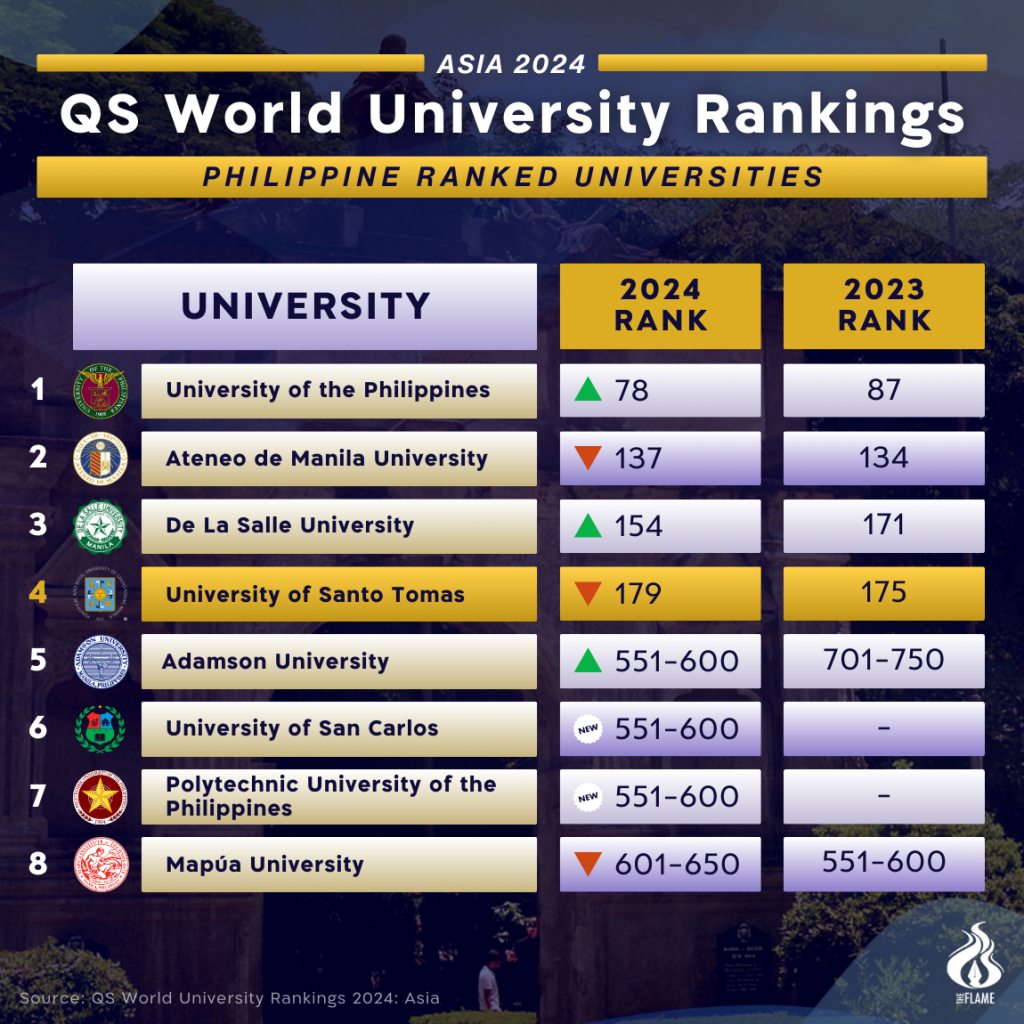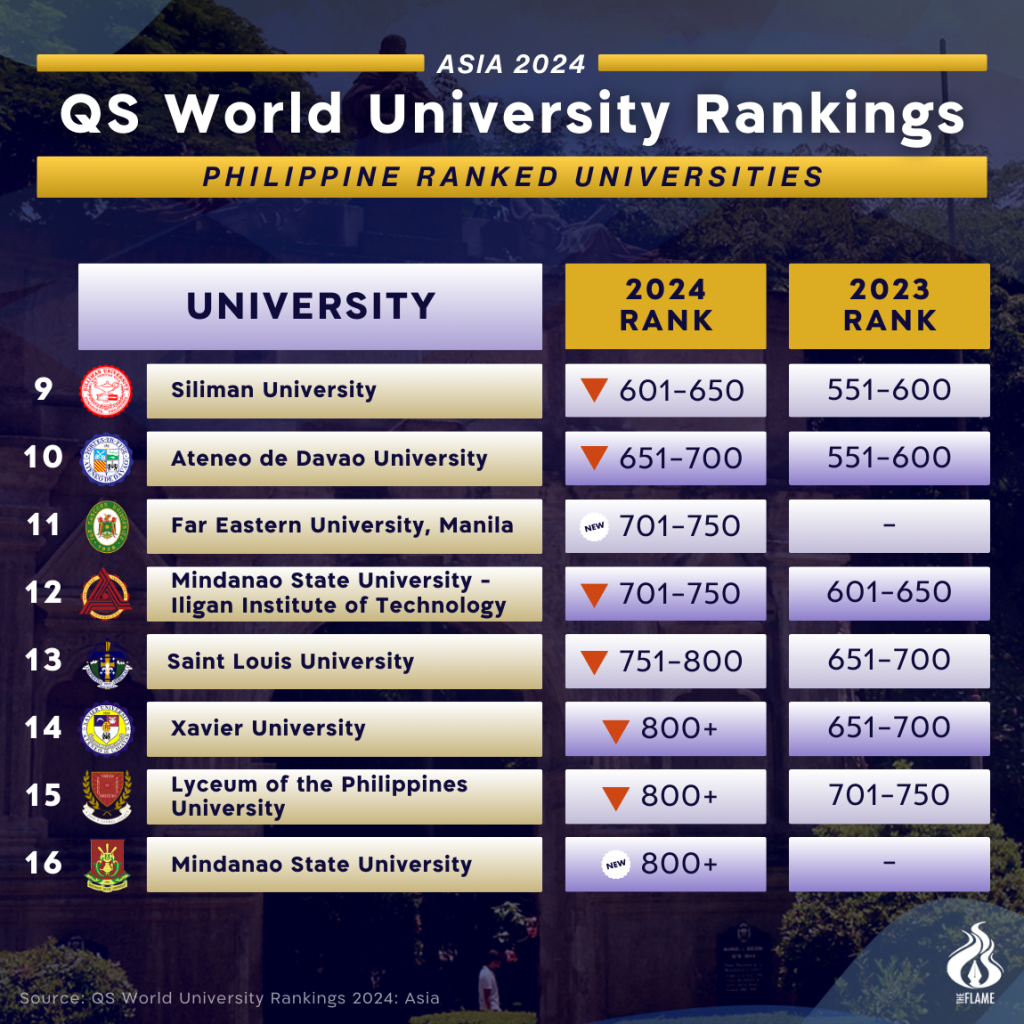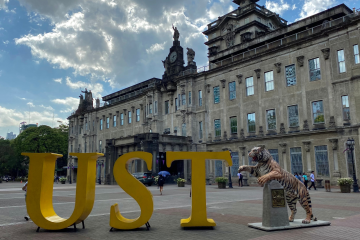
THE UNIVERSITY of Santo Tomas (UST) remained the Philippines’ fourth-best educational institution in the 2024 Quacquarelli Symonds (QS) Asia University Rankings but fell by four spots among schools in the region.
UST ranked 179th overall in the latest edition of the assessment, slipping from 175th place in the previous year.
Despite the lower overall ranking, UST retained its status as the fourth leading institution in the Philippines, excelling in student exchange programs and international outlook.
It was behind University of the Philippines (78th), the country’s top university; Ateneo de Manila University (137th) and De La Salle University (154th). However, UST ranked higher than Adamson University (551-600), University of San Carlos (551-600), Polytechnic University of the Philippines (551-600), Mapua University (601-650) and eight other Philippine institutions.
Four Philippine universities were included in the assessment for the first time: University of San Carlos (551-600), Polytechnic University of the Philippines (551-600), Far Eastern University – Manila (701-750) and Mindanao State University (801+).


QS Senior Vice President Ben Sowter said UST has a “highly international outlook,” citing its stronger employer reputation, which improved to 92nd from 95th previously. UST’s performance in the area signifies its appeal to overseas talent, he added.
“The University of Santo Tomas continues to see its employer reputation grow, reflecting the work readiness of its graduates and serving to further expand their career prospects and employment outcomes,” Sowter told The Flame through a representative.
UST also emerged as the university with the best student exchange programs in the Philippines, being the only institution to rank in Asia’s top 200 for the outbound exchange students (11th) and inbound exchange students (51st) indicators. It also obtained the country’s highest rank for international faculty (60th) and international students (172nd).
Investment in research still lacking
Despite achieving the country’s top ranks in four of the 11 performance indicators, Sowter said UST lagged behind in the research metrics with other Philippine institutions.
“In line with Philippine universities more broadly, the University of Santo Tomas faces challenges in research metrics, such as its citation count, its publication output and its cross-border collaboration,” Sowter told The Flame.
“The clearest way for the university to ascend the table and excel among its domestic peers is to invest in relevant contemporary research and supplement this by spearheading multinational partnerships.”
UST got a 301+ rank in faculty-student ratio, international research network, citations per paper and papers per faculty and staff with a PhD. It was also the only one among the country’s top four universities to be excluded from Asia’s top 100 for academic reputation, where it ranked 173rd.
According to QS, the Philippines struggles in the research metrics as its institutions failed to secure a ranking in the top 100 for QS’ measures of research productivity, impact or collaboration.
The country is also challenged by its teaching resources, QS said, citing the faculty per student and faculty expertise indicators. It added that no Philippine university placed in the top 500 for staff with a PhD.
In a press release, Sowter said the Philippines should invest in producing high-quality and relevant research to enhance universities’ academic reputation, which covers 30% of the assessment’s weight.
“[I]f they (Philippine universities) hope to enhance their academic reputation, focus needs to be placed on employing the highest quality staff possible and investing in high quality, relevant research,” he said.
A total of 856 institutions across 25 countries were ranked in the 2024 QS Asia University Rankings based on their global recognition, research prowess, teaching resources and internationalization.
Peking University in China retained its top spot in the region, followed by the University of Hongkong and the National University of Singapore. F



